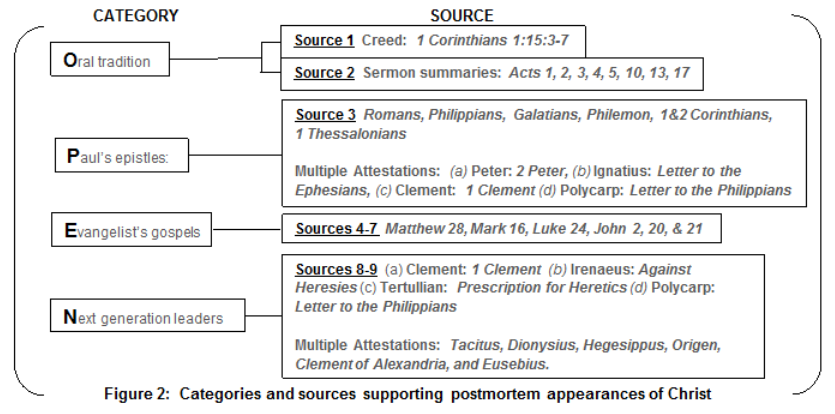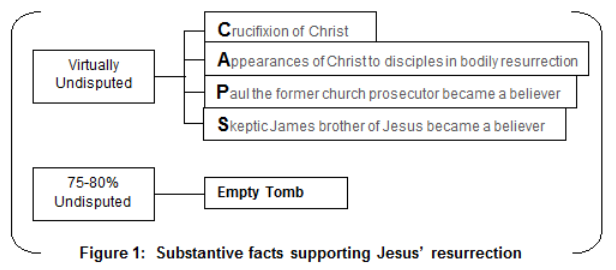For writers of the New Testament, Jesus’ resurrection was the focal point of their teachings. The apostle Paul was adamant concerning the importance of the resurrection when he wrote: And if Christ has not been raised, your faith is futile; you are still in your sins 1 Corinthians 15:17 (NIV). This historical test of truth leaves no room for ambiguity. Christianity stands or falls based on the risen Christ. In fact, the resurrection loses its apologetic value unless it is a physical resurrection of the same body that died.[1]
In view of the common objection that Jesus was raised, we will examine historical data using Dr. Gary Habermas’ minimal facts approach. If we are successful, we will build a strong foundation that shows the resurrection claim is grounded on solid history, and, in turn, will enable us to safely share compelling evidence in defense of our Christian faith.
The skeptic asks challenging questions that demand answers: “What are the best sources in support of the resurrection of the historical Jesus?” “Are there any persuasive facts concerning Jesus’ resurrection for which all scholars agree?” How will you address these questions? It is almost a guarantee that most people will not listen patiently through a ten minute response. It’s imperative when sharing our faith to be able to cogently summarize an argument, and then handle follow-up questions. As the apostle Peter stated: Always be prepared to give an answer to everyone who asks you to give the reason for the hope that you have 1 Peter 3:15b (NIV). Given that other religions and worldviews make “one-way-only” claims of their own, where does the Christian begin?
According to Dr. Habermas, minimal facts are represented by three core criteria for evaluating the resurrection claim: (a) it uses only the strongest historical evidence based on universally accepted criteria; (b) it uses only historical evidence conceded by virtually all critical scholarship; and (c) while the Bible is divinely inspired, it treats the Bible as another book of ancient literature, i.e. divine inspiration is not used to advantage.[2] The beauty of the minimal facts approach eliminates the burden of brute memorization of numerous details, yet provides key facts required to build a substantive case for Jesus’ resurrection. The skeptic will need to respond.
Credible historiography, according to Habermas, is dependent upon the historical principles of multiple, independent, early, eye witness testimony. While firsthand testimony is ideal, an “eyewitness of an eyewitness” is also strong historical evidence.[3] Non-Christian authors and embarrassing testimony are also considered highly reliable. In addition, when it comes to history, we can only speak of probability; nothing can be established with 100% certainty. When dealing with historical topics, we follow the weight of the data, much in the same way as the judicial system when solving crimes.
Based on minimal facts criteria and credible historiography summarized above, Habermas cites four virtually undisputed historical facts concerning the resurrection accepted by critical and conservative scholars. At the risk of redundancy, these facts will be referred to using the acronym C.A.P.S.: (C)rucifixion of Christ, (A)ppearances of Christ to the disciples in bodily resurrection, (P)aul, the former church prosecutor, became a church promoter to the point of martyrdom for his belief in the resurrection, and the (S)keptic James, brother of Jesus, became a church leader and martyr for his belief that Christ was raised.[4]
In addition to the four undisputed facts, Habermas espouses solid evidence for the Empty Tomb. Had Jesus’ tomb been occupied, it would have been impossible for Christianity to get started in the same city (Jerusalem) where Jesus was publicly executed. Moreover, the empty tomb was enemy attested by non-Christian sources. In addition, the empty tomb was discovered by women who were not considered to be credible witnesses in first century Palestine. Why would authors knowingly invent data that would hurt the credibility of their story? According to Habermas, the empty tomb is 75-80% undisputed.[5] When the stone was rolled away, the evidence clearly shows that Jesus’ tomb was not occupied. JESUS IS ALIVE. We cannot say the same for Muhammad, Confucius, and Buddha.
Figure 1 summarizes the five substantive facts (above)
As with all valid historical arguments, assertions are meaningless without the historical sources to justify their claims. Based on Dr. Habermas’ and Dr. Licona’s book, The Case for the Resurrection of Jesus, we will examine in more detail the “central point” of the resurrection argument, the appearances of Christ to the disciples, which is the “A” in C.A.P.S. Nine independent sources are cited that employ four categories of historical data.
For ease of memorization, the categories are represented by the acronym O.P.E.N.: The “O” stands for the category oral tradition in support of the earliest church creeds. The “P” stands for the category Paul’s epistles. The “E” stands for the category evangelist’s gospel accounts. The “N” stands for the category next generation leaders who were eyewitnesses of those claiming to be eyewitnesses of the resurrection.[6] Again, brute memorization is not required. Most of the time, a summary of the four categories of O.P.E.N. without introducing detailed sources is generally a sufficient argument. In fact, this summary would place you well ahead of what the majority of Christians know concerning resurrection apologetics.
Figure 2 incorporates the categories and sources pertinent to the appearances of Christ in bodily resurrection. Additional details are included in the textual source descriptions that follow.

For Part 2, please click here.




